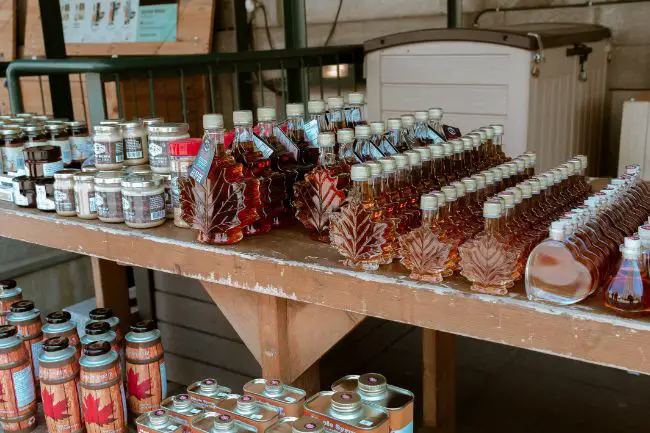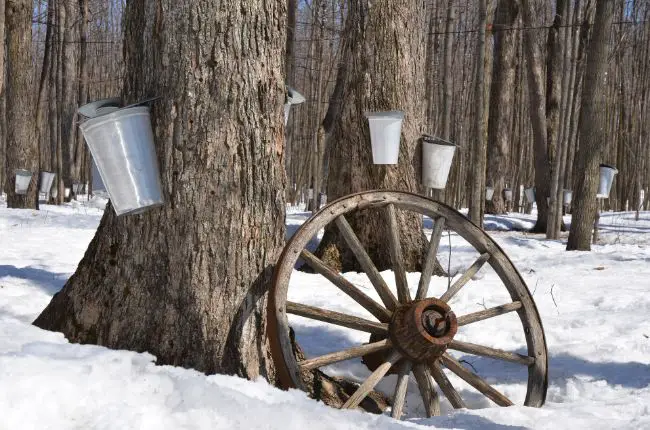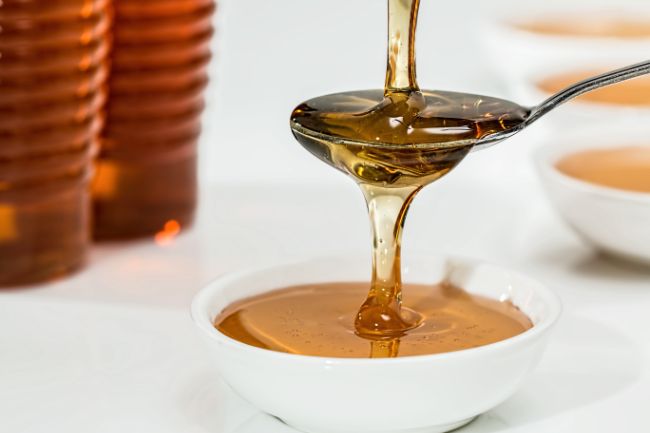In the world of sweeteners, it’s fair to say that maple syrup is very similar to honey. One commonly known fact about honey is that it can be used to produce a delicious alcoholic beverage called mead.
So, if honey ferments, then surely maple syrup must as well, right? Right!
Ales and a special kind of alcohol called acerglyn can be brewed from fermented maple syrup.
In the past, maple syrup makers would ferment the season’s darkest, least desirable saps so that customers may sip on them all winter long.
It’s a great Canadian custom to ferment maple syrup, and the rest of the world is catching up.
Now, let’s find out what goes into making this unique alcoholic beverage.

Defining Maple Syrup
Before we get into brewing, let’s be clear about what maple syrup is. Despite its popularity, not everyone knows what maple syrup is made of.
Most of the “maple syrup” we get from grocery stores isn’t the real thing (we’re looking at you, Aunt Jemima, and Mrs. Butterworth).
Artisans produce maple syrup by tapping maple trees that can reach heights of over five stories! The collected syrup is then reduced by boiling.
As the sugars caramelize and undergo chemical changes while boiling, the color changes to brown, indicating a richer, darker flavor.
The sap is tapped from maple trees that can reach heights of over five stories; then, the syrup is reduced by boiling.
The first Westerners to manufacture maple syrup did so in Canada and the Northeastern US, where indigenous people had been using maple tree sap for centuries.
What Are The Outcomes If You Ferment Maple Syrup?
Many drinks can be made by fermenting maple syrup in various ways. Ale can be created from it, with the addition of hops for extra flavor. You can also make hard apple cider, which is best enjoyed in the fall.
For a unique twist on the standard winemaking and aging processes, some vintners are using maple syrup instead of grape sugar.
Similarly, some forward-thinking distilleries are employing maple syrup to create hard liquor and spirits, albeit often in lower proportions, as a flavoring agent rather than the main sugar.
Most brewers choose to use gentler fermentation procedures. They choose not to boil the maple syrup so that its distinctive flavor is preserved in the finished product.
Also, as maple syrup is pricey and should be used sparingly, this helps keep the cost of the recipe’s other ingredients down.
When preparing acerglyn (or maple mead), the maple syrup is added off heat. Brewing maple beers and ales also calls for sterilized maple sap, not syrup.
Secondary fermentation (rather than primary) is the time to add maple syrup, which will intensify the beer’s distinctive maple flavor.
Making Maple Mead
Make sure you have plenty of pure maple syrup and the appropriate equipment before beginning the production of maple mead or wine.
A home brewer’s kit is something you should look into. These kits often include a fermenter, thermometer, yeats, airlock, hydrometer, siphons, and vessels.
Ingredients For Making Maple Mead (Acerglyn)
- 2 lbs. Clover honey
- 1 gal. dechlorinated water
- 1 packet of white wine yeast
- 12.5 oz. Grade B pure maple syrup
- ½ teaspoon yeast nutrient
Steps:
- Get started by sterilizing all of your brewing tools. If you’re going to be using scissors to open the yeast packet, you should clean them too.
- Get a gallon of dechlorinated water and fill a jar with it.
- Use a funnel to add the honey to the water.
- Mix the maple syrup with the honey and water.
- In order to hasten the fermentation process, shake the jar to distribute air throughout the contents.
- Throw in some white wine yeast and yeast nutrition.
- It’s time to put that hydrometer to use. Get a reading of the gravity and make sure it falls between 1.042 and 1.090.
- Attach the airlock and stopper.
- The ingredients should be allowed to ferment for 30 days. Keep the space at a comfortable 66 to 76 degrees Fahrenheit. After 30 days, you should try the mead. Keep fermenting for another week if you think it’s too sweet.
- It’s time for bottling if you think the mead is ready!
Making Maple Wine

If you don’t want to use honey at all, you can use your maple syrup to brew maple wine.
Ingredients For Making Maple Wine
- 5 lbs. Pure maple syrup
- 3 tsp. Malic acid
- 1 ½ tsp. Tartaric acid
- 5g champagne yeast
- 1 tsp yeast energizer
- 1 gal. Distilled water
- ¼ tsp. Wine tannin
Steps:
- Clean and disinfect all of the equipment first. In order to get the best results from your wine or maple mead, you must first ensure that your tools are clean.
- Put a gallon of water in your brewer.
- Next, add the maple syrup. Maple syrup and water should be combined with a stir. Bubbles in the water, created by mixing, aid in the fermentation process.
- At this point, take a reading of your gravity. If you reach 1,100, the alcohol content of the maple wine will be at least 10%.
- The additives should be mixed in next. Add the tartaric acid and malic acid. The presence of these two components delays the mixture’s degradation. Your wine’s final flavor is likewise affected by these ingredients.
- Incorporate the tannins into the wine. The drink’s mouthfeel is modified by this component. Wood and bark are excellent natural sources of tannins.
- Next, add in the yeast energizer. This is food for the yeast that will be added later. The sugars in maple syrup are not sufficient to sustain the fermentation on their own. Therefore a yeast energizer must be added.
- The yeast should be added very late in the process.
- After incorporating the yeast, give the mixture a good shake to distribute the yeast throughout.
- Put the lid on and airlock on the container.
- Store your concoction in a cool, dark area for two weeks. You may find out how much alcohol is in your beverage by taking another gravity reading after two weeks.
- When the taste of the wine is just right, it’s time to bottle it.
What Will Your Fermented Maple Syrup Taste Like?
Fermented maple syrup can have a range of flavors, depending on the fermenting process and the maple syrup used.
One example is the dry, yet refreshing taste of maple mead. Maple mead fermented from grade B maple syrup supposedly yields a more robust flavor, as claimed by mead makers.
There are a number of variables that can impact the taste of maple wine. There’s a chance that maple wine aged in whiskey barrels will take on the flavor profile of bourbon. In contrast, maple wine can be made less sweet by mixing in some fresh lemon juice.
In general, maple wine is typically sweet without being overly cloying.
Can You Ferment Fake Maple Syrup?
Fake maple syrup is made with corn syrup. Some brands of imitation maple syrup may have a different ingredient list than others.
Please note that fake maple syrup can cause hypertension, insulin resistance, and weight gain when used frequently or in excessive quantities.
Some “fake” versions of maple syrup might even have food additives such as artificial colorants and flavor enhancers.
Although both types of maple syrup include a lot of sugar, true maple syrup has fewer additives and is therefore healthier.
So, the next question is whether or not imitation maple syrup can be fermented. Well, technically, yes. Providing it contains some form of natural sugar, imitation maple syrup can be fermented. But will it taste good?
Artificial maple syrups don’t really taste like maple at all. Cidery aromas and flavors may become dominant after fermentation.
Fermenting fake maple syrup with fenugreek seeds is an option. The flavor and aroma they produce are quite similar to real maple syrup.
What Can You Do To A Bottle of Maple Syrup That Has Already Fermented?

Accidentally fermented maple syrup in the pantry could still be put to good use.
First, give it a good whiff. Most commercially available maple syrup has been processed to kill any microorganisms that might naturally present in the product. If the maple syrup has fermented, it may be spoiled and should not be consumed.
Just go with your gut instinct here. It’s still usable if it smells strongly of yeast and beer without being offensive. Whenever you notice mildew, discoloration, or a foul odor, it’s time to toss it.
Second, you probably don’t have enough maple syrup to make alcohol if it’s just one bottle that’s fermented. A lot of maple syrup is needed to make acerglyn or maple beers and ales. Consider the following options:
Option 1
Maple syrup is a great complement to any other fermented drinks and condiments. Fermented maple syrup can be used in place of sugar in recipes like kombucha, apple cider vinegar, hot sauces, and chutneys. Your maple syrup will add depth and sweetness to your recipe.
Option 2
Maple vinegar can be made by storing fermented maple syrup in an airtight jar with vinegar mother for a few weeks or months. Adding the sweet and sour flavor of maple vinegar to salad dressings, marinades, and other dishes is a great idea.
Option 3
You might be able to salvage a bottle of maple syrup that has developed a thin coating on top and smells somewhat sour.
The syrup can be poured into a pan after skimming off the developed film. Bring it up to a simmer and cook it for 5-10 minutes at 195 degrees. Then, transfer the liquid to a clean, sterile container.
When maple syrup is heated, the fermentation bacteria are killed, and the syrup can be used as usual unless the fermentation process has advanced far enough to alter the flavor significantly.
Related Reading: Here’s a Great Maple Wine Recipe You Can Try – Check Them out Here
Final Thoughts
It’s no mystery why maple sap is tapped for syrup production; it’s inherently sweet. It also makes sense to ferment these sugars to produce alcohol.
Some alcoholic beverages, such as those brewed or distilled, can benefit from the delicate caramel flavor that maple syrup can impart.
And due to the presence of wild yeast, maple syrup can potentially ferment on its own! It’s such an awesome ingredient.